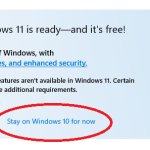Thought Leadership
Studying The Science of Retail Since 1979
Best POS System for Restaurants | Top Features & Benefits

Running a restaurant involves juggling numerous operational aspects, from managing orders to tracking inventory and ensuring customer satisfaction. A robust Point of Sale (POS) system is not just a to… Read More
Upgrading to Windows 11? Read This First.

If you use any Windows 10 computer these days you and your staff may have recently noticed that the existing Windows 10 version you’re running has been recommending upgrading to Windows 11 in va… Read More
Windows 7 End Of Life

Windows 7 EOL And What It Means For Your Point of Sale It is widely distributed public information that after a good 10 year run, Microsoft has scheduled the Windows 7 end of life (EOL) on January 14t… Read More
Integrated Credit And Debit: Why Merchants Should Insist On It

One Feature Can Streamline The POS, Reduce Shrinkage and Theft, and Improve Manageability With Minimal Effort Have you noticed as you shop that nearly every multi-unit retail store operator or restaur… Read More
POS Systems And Risk Management

Is your POS prepared for the perfect storm? The #TorontoFlood last night seemed to have caught everyone by surprise. Especially folks in West Toronto! Power was knocked out to over 1 million customers… Read More
POS Penny Pinching – The Death Of The Canadian Penny

How The Elimination Of The Canadian Penny Will Affect You At The Point Of Sale Today marks the death of the Canadian penny. Soon to be eliminated at the POS. Born in 1876, at the ripe old age of 137 y… Read More
